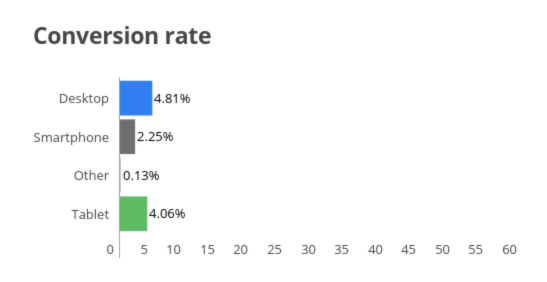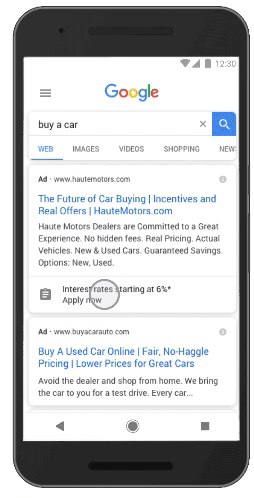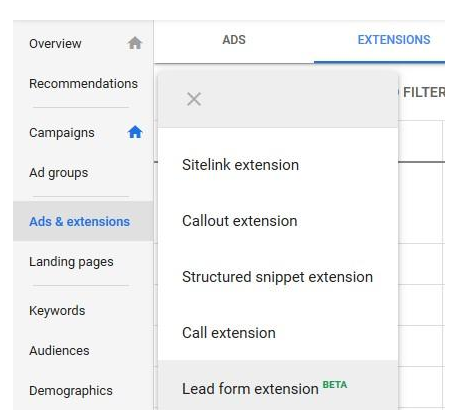Recent data shows that mobile conversion rates are lower than desktop:

To combat this situation Google introduced the newest addition to mobile search ads — lead form extensions. The ad type is similar to LinkedIn lead gen form ads and Facebook lead ads in terms of the lead capture process.
So, do lead form extensions, like the rest of Google’s extensions, help with conversions or do they have shortcomings similar to LinkedIn and Facebook? Today’s post will examine what Google lead form extensions are and if they help advertisers maximize campaign results instead of sending prospects to dedicated post-click pages.
What are Google lead form extensions?
Lead form extensions help you immediately capture user information when they search for your company, products, or services on Google. The extension was created to replace the need for directing prospects to a post-click page to convert.
Ads that use the extension show a form beneath the search ad on mobile and tablet devices which allows prospects to enter their contact information directly in the ad’s popup form:

It is currently in beta and isn’t available to all advertisers yet, but to check if your business is eligible, go to this link.
How do lead form extensions work?
They simplify the process of collecting user information by placing forms within the ad and allowing prospects to commit to your offer instantly. Moreover, when a user sees an ad while they’re signed into their Google account, they can tap the CTA and reach a Google-hosted form already pre-populated with their information. This sequence makes the lead capture process possible with a single tap.
From their initial Google search to form submission, it only takes a few seconds for prospects to connect with your business. For advertisers, creating the lead form extensions also takes just a few seconds, click the “Ads and Extensions” tab on your search ad account. If your account has access to the beta version, clicking on the blue “+” will give you the drop-down menu with the lead form extension:

The extension allows you to select what information you want to collect from prospects, including the following fields:
- Name
- Phone number
- Postal code
Along with the form fields, these are the CTA button copy options:
- Get offer
- Subscribe
- Download
- Apply now
- Book now
- Contact us
- Get quote
- Sign up
The platform allows advertisers to add a background image to appear as the lead form screen, with recommended dimensions 1200 x 628 and an aspect ratio of 1.91:1. You can also create a form submission message, usually a thank-you note, that prospects see the after they’ve submitted the form.
The form specs
When creating your lead form extension, you must adhere to these specs:
- Business name: 30 characters
- Headline: 30 characters
- Description: 200 characters
Apart from allowing advertisers to collect leads from within the ads, the Google extension also has the following advantages.
Pros of lead form extensions
The extension allows you to bypass sending users to another page and get their contact information instantly. Plus, you can add a link to your website in the submission message in case prospects want to find out more about the offer or your brand.
Google also provides you with two options to reach out to the prospects who have submitted their information:
- Download leads as a CSV: The “download leads” link allows you to get the contact information from each lead form extension. However, Google will only store leads for 30 days, so you’ll need to download these leads often.
- Set up a webhook integration: You can also enter the new leads directly into a CRM. To do this, you need to add a webhook URL and key to your lead form extension. Once everything is integrated, you’ll be able to send test data to view testing stats and results.
Although the extension seems like a godsend for lead generation, they have a number of disadvantages.
Cons of lead form extensions
Before you go all-in on this new extension, consider the following as they relate to your campaigns:
- They are only available on mobile: Lead form extensions are only eligible for mobile search campaigns.
- Extensions can only be applied at the campaign level: You cannot create lead form extensions at the account level or ad group level.
- Your industry might not be eligible for the extension: Some sensitive industries (such as healthcare) will not be able to collect personal information with lead form extensions. For a full list of restrictions for the extensions, visit this page.
- Google has strict data collection policies: The personal information you collect with lead form extensions must comply with your company’s provided privacy policy, Google’s data collection policies, and the local legal requirements of your users.
- Limited form field options: Unlike your post-click page’s form where you decide which information you want to collect, Google currently allows very little customization with form fields. You can only ask for the user’s name, email, phone number, and zip code.
- You miss out on a personalized introduction: Convincing prospects to click the CTA button on a pre-filled form seems easy. However, you miss out on properly introducing them to your brand. They might have clicked your ad, but would they convert if they don’t know all the details they wanted. This is what your personalized post-click landing page provides.
- You don’t have access to useful user data: When prospects don’t land on your post-click page you can’t see how your visitors would have interacted with the page, making you miss out on useful analytics data, potential ad revenue, and other branding opportunities.
Google lead form extensions seem like a quick and easy way to collect leads; however, the quality of leads collected will not be nearly as high as a personalized post-click landing page. A well-designed personalized page experience can achieve exactly what Google lead form extensions can. Plus, a dedicated page gives prospects a better introduction to the offer and your brand while giving them relevant offer details, which helps them make an informed decision.
Always use post-click pages to collect high-quality leads
Making forms easier to complete can contribute to better campaign performance. However, using Google lead form extensions does not guarantee campaign success. They help prospects immediately fill out forms, but they also have many disadvantages, first and foremost the lack of messaging personalization.
Instead of depending on forms within the ad to generate conversions, invest your efforts in creating a balanced and highly personalized post-click landing page. This helps you convert ad clicks into conversions on a page you’ve designed specifically for the prospect who arrives on it.
Learn how to personalize your post-click landing pages at scale by signing up for an Instapage Personalization demo today.

See the Instapage Enterprise Plan in Action.
Demo includes AdMap™, Personalization, AMP,
Global Blocks, heatmaps & more.
